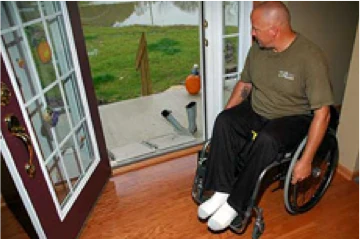People with Disabilities, Including Developmental Disabilities
Many individuals with a disability live on a small, fixed income, limiting their ability to pay for housing. Individuals with mental, physical, and developmental disabilities need affordable, conveniently located housing that has been (or can be) specially adapted to address accessibility issues and include on- or offsite support services, including inpatient/outpatient day-treatment programs.

Special needs are those associated with specific demographic or occupational groups that call for specific program responses, such as preservation of single-room occupancy hotels or the development of units with larger bedroom counts. The statute specifically requires analysis of the special housing needs of people who are elderly or disabled (including developmental disabilities), female-headed households, large families, farmworkers, and people experiencing homelessness. These special-needs groups often spend a disproportionate amount of their income to secure safe and decent housing and are sometimes subject to discrimination based on their specific needs or circumstances.
In addition to the groups listed above, the analysis of special needs should also include any other group the locality deems appropriate such as student populations, Native American tribes, people with HIV/AIDS, etc.
Government Code
Government Code Section 65583(a)(7)) requires “An analysis of any special housing needs, such as those of the elderly, persons with disabilities, including a developmental disability, as defined in Section 4512 of the Welfare and Institutions Code; large families, farmworkers, families with female heads of households, and families and persons in need of emergency shelter…”
Requisite Analysis
A thorough analysis will assist a locality in identifying groups that have the most-serious housing needs in order to develop and prioritize responsive programs. The analysis of each special-needs group should include the following:
- A quantification of the total number of persons and households in the special housing needs group, including tenure (rental or ownership), where possible.
- A quantification and qualitative description of the need (including a description of the potential housing problems faced by the special needs groups), a description of any existing resources or programs, and an assessment of unmet needs.
- Identification of potential program or policy options and resources to address the need.
In addition to the requisite analysis above, a thorough analysis of the special housing needs for persons with disabilities should include:
- A discussion of resources, including existing housing and services for people with disabilities. Contact local, service providers such as the local Center for Independent Living, county health/mental-health departments, health-related nonprofits (e.g. United Cerebral Palsy, Crippled Children’s Society, Heart Fund, Lung Association, Diabetes Association, Cancer Society, etc.) or school districts that maintain the number of students enrolled in special education programs, students requiring special accommodations and/or transportation, and students participating in home schooling.
- Identification of housing types (e.g. residential care facilities) that can accommodate people with disabilities and zoning and capacity available to facilitate these housing types.
- Housing programs or strategies to address identified needs.
Sample Tables
The following sample tables can help in organizing critical information. The information provided in the tables should be tailored to the jurisdiction and followed by appropriate analysis. (Note: These tables are not intended to substitute for addressing the analytical requirements of housing-element law.)
| Persons with a Disability (by Employment Status) | ||
|---|---|---|
| Number | Percent | |
| Age 5-64, Employed persons with a disability | ||
| Age 5-64, Non-employed persons with a disability | ||
| Persons age 65+ with a disability | ||
| Total persons with a disability | ||
| Total population (civilian non-institutional) | ||
Source: U.S. Census Bureau
| Persons with Disabilities (by Disability Type) | ||
|---|---|---|
| Number | Percent | |
| Total disabilities | ||
| Total disabilities for ages 5-64 | ||
| Sensory disability | ||
| Physical disability | ||
| Mental disability | ||
| Self-care disability | ||
| Go-outside-home disability | ||
| Employment disability | ||
| Total disabilities for ages 65+ | ||
| Sensory disability | ||
| Physical disability | ||
| Mental disability | ||
| Self-care disability | ||
| Go-outside-home disability | ||
Source: U.S. Census Bureau
Helpful Hints
Chapter 507, Statutes of 2010 (SB 812), which took effect January 2011, amended state housing-element law to require the analysis of people with disabilities to include an evaluation of the special housing needs of persons with developmental disabilities. A "developmental disability" is defined as a disability that originates before an individual becomes 18 years old; continues, or can be expected to continue, indefinitely; and constitutes a substantial disability for that individual. This includes mental retardation, cerebral palsy, epilepsy, and autism. This analysis should include an estimate of the number of persons with developmental disabilities, an assessment of the housing need, and a discussion of potential resources. While, the U.S. Census does not have specific information regarding people with developmental disabilities, each nonprofit regional center contracted with the California Department of Developmental Services maintains an accounting of the number of people served by zip code or city. This information can be used to estimate the number of people residing in the jurisdiction that have developmental disabilities.
The Mental Health Services Act (MHSA) approved by the voters in November 2004 funds activities that expand mental-health services to children, adults, and seniors with severe mental illnesses who cannot obtain services through other funds. MHSA requires that each county submit a MHSA plan to the state in order to secure funding. Each county’s plan contains pertinent information on persons with disabilities that may be useful in preparing the special-needs analysis. Information is available by calling the Department of Mental Health at (800) 972-6472.
Sample Table
| Persons with Developmental Disabilities (by Age) | ||||||
|---|---|---|---|---|---|---|
| Zip Code | 0 to 14 years | 15 to 22 years | 23 to 54 years | 55 to 65 years | 65+ years | Total |

